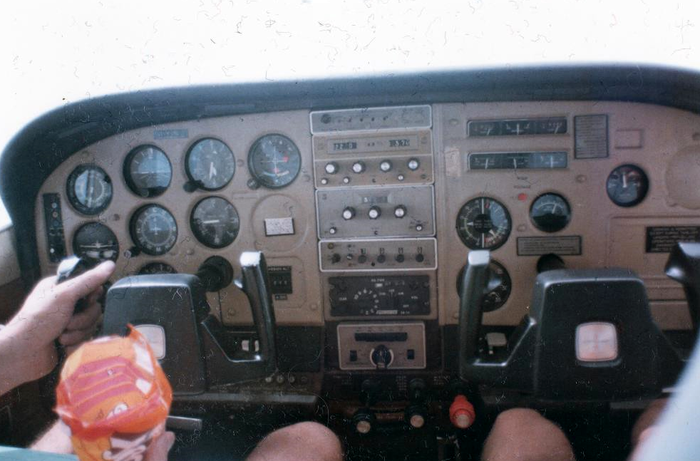Australian Aviation Barrister
Home | Articles | Events Flying | Video Clips | About | Contact

The 206 panel in 1987 while having a snack
Full trim at Kalumburu landing.
We were in our 206 (EPL), five of us flying around Australia for a month on a second trip. It was 11 May 1987. After a few very pleasant nights at Broome, we flew to Cape Leveque. It was impressed on us in Broome that we required permission to land. We decided not to land but to fly over it and have a look. This negated the need to be troubled about a clearance. We were flying to Kalumburu.
We followed the coast low from Broome up the Dampier Peninsula to Cape Leveque. Cape Leveque was the first sign of civilisation after Broome. It looked lovely. I put down ten degrees of flap to commence a slow circuit of the area. We flew a full circuit over this beautiful looking place. White beaches, red cliffs, a couple of buildings and a lawn, a light house on the high point and a good-sized red dirt runway with tall trees at the inland end.
Ian was sitting up front with me. It was all too much for him. He said with a positive ‘don't be a wimp’ tone “Put the bloody thing on the ground”.
The runway on closer inspection looked a bit rough with wash-outs running away from the raised centre of the runway. We flew a low lever inspection of the strip. I was comfortable so long as we stayed in the centre. There was a sea breeze running. We landed towards the water coming low over what appeared to be a planation of trees. We stayed on the centre.
We pulled up as near as I could to the only building near the strip. We were warmly welcomed by the resident manager. A very nice chap, tall with a good brow. We mentioned the lack of a permit with apologies. He dismissed our concern saying it was something the local aviators in Broome took on hoping to get a job.
We swam, fished and were taken mud crabbing before a huge feed of fish presented to us by the resident cook but cooked by the Manager. What a great night it was! Barbecued fish was consumed until we could eat no more.
Three of us slept in one tent, Antony slept under a Frangipani tree and Ian went missing. The next morning after calling his name repeatedly and loudly, the curtain on the cook's caravan moved - “What do you want?”
There was no fuel at Cape Leveque. I knew this before landing. I was comfortable with what we had. After a very decent breakfast, we took off east towards the trees in the opposite direction to landing. I had cancelled my SAR the day before by using the manager’s ground line. I used it again to get weather and NOTAMs and file a plan before departing. It was a truly lovely flight out over the Bonaparte Archipelago. The water was a mill pond. We tracked north to the Prince Regent River. There we turned east to follow the steep sides of the river gorge to a predetermined point before turning north to fly over Mitchell Plateau to say “G’day.” On 29 March that year an American 24-year-old model named Ginger Meadows was tragically taken in this river by a crocodile. The scenery around this part of the world is wonderful. The flight from Cape Leveque to Kalumburu on the route we flew was so very scenic. That said, it is not recommended for those in a single engine aircraft lacking faith in their engine. It is all tiger country. Sharks and crocodiles if you visit the water and rocky terrane elsewhere. We flew for two hours 54 minutes on this leg.
I had pre ordered a 44-gallon drum of fuel for our arrival at Kalumburu. When the 206 burns fuel, the centre of gravity moves to the back. This is particularly noticeable when the back is already heavy with baggage. As one flies you are unconsciously adding nose down trim to hold the attitude as the C of G moves back. This movement of trimming the aircraft went unnoticed until suddenly the trim wheel moved no more. This was a first for me. We had full nose down trim.
I bent down to see what the hell had gone wrong with the trim wheel. Trim wheels never stop! This one had. I turned it the other way - it moved freely. There was no avoiding it, we were on full nose down trim in a cruising attitude!
Soon Antony had to push gentle pressure on the yoke to maintain our attitude. I asked the very back passenger to move what could be moved from the baggage area to those in the middle row to be nursed. This helped but soon more nose down pressure was required.
Fortunately, we were not far out from landing. Slowing the aircraft induced more attitude problems. Lowering flap required positive forward yoke pressure as the plane tends to pendulum from the flap air drag on the high wing. The prospect of doing a go round was most unattractive. A very strong nose down pressure would have been required.
We landed first attempt but with a considerable forward pressure on the yoke. It was also hot - I mean hot. The density altitude was certainly not sea level where it should have been at Kalumburu. I forgot to mention, we were low on fuel to the point I had burnt out the left tank en-route. None of our remaining flights caused the trim to run out. I suspect it was a combination of low fuel and a weighty back passenger on that flight leg. A configuration not repeated.
© C McKeown 2021.